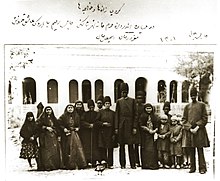Contents


The harem of the monarchs of the Qajar dynasty (1785-1925) consisted of several thousand people. The harem had a precise internal administration, based on the women's rank.
Hierarchy and organisation
Mother of the Shah
As was customary in Muslim harems, the highest rank of the harem hierarchy was that of the monarchs' mother, who in Qajar Iran had the title Mahd-e ʿOlyā (Sublime Cradle). She had many duties and prerogatives, such as safeguarding the harem valuables, particularly the jewels, which she administered with the help of female secretaries.[1]
Consorts
In contrast to what was common in the Ottoman Empire, where the sultans normally only had slave consorts, the Qajar shah's also had a custom of diplomatic marriages with free Muslim women, daughters of Qajar dignitaries and princes.[2] Another phenomena of the Qajar harem was that the Shah entered two different kinds of marriages with his harem women: ṣīḡa (temporary wife), which was often done with concubines, and ʿaqdī (permanent wife), which was a promotion.[3] The wives and slave concubines of Fath-Ali Shah Qajar came from the harems of the vanquished houses of Zand and Afšār; from the Georgian and Armenian campaigns, as well as from the slave markets (see Circassian slave trade) and presented as gifts to the shah from the provinces.[4][5]
Staff
Every consort had white and black slave servants (women or eunuchs), whose number varied according to her status. Some wives had their own residence and stables.[6]
There were different types of female officials within the harem: some managed the royal coffeehouse inside the harem; a body of female sentinels commanded by women officials "protected the king's nightly rest";[7] women called ostāds (masters), supervised the group of female dancers and musicians who entertained the harem and were housed with their servants in a separate compound.[8]
Young slave boys below puberty (ḡolām-bačča) served as servants and playmates in the harem.[9] Eunuchs were mainly African slaves.[9]
The women of the harem were responsible for everything inside the harem quarters, but the harem were guarded from the other parts of the palace (biruni) by the eunuchs, who together with the visits from relatives, physicians and tailors served as links to the outside world for the women, but the women were normally not allowed to leave the harem themselves except with special permission.
The harem as a social and political institution
The harem women had daily entertainments such as music, dance, theatrical performances and games. They studied the arts, calligraphy and poetry, and entertained themselves and the shah with music, dance and singing, and by reciting verses and telling stories, which the shah enjoyed at bedtime.[10] The harem had its own theatre where passion plays (taʿzia) were performed, and one of the shah's wives was the custodian of all the paraphernalia.[11] Toward the end of the Qajar dynasty, foreign tutors were allowed into the harem.
Inside the harem, women performed religious functions such as rawża-ḵᵛāni (commemoration of the martyrdom of Imam Ḥosayn at Karbalā); preached from the pulpit on the day of ʿĀšurā (q.v., the 10th of Moḥarram) and direct the ritual of sina-zadan (beating of the chest).[12]
The Qajar harem also had the political influence and intrigues common in royal harems. Until a regulated succession order to the throne was established by Nāṣer-al-Din Shah (r. 1848–1896), the harem was a place of intense struggle by mothers of potential heirs to have their own sons elected heir to the throne as well as material benefits for themselves, higher ranks for members of their own families, or precedence for their own children. Nāṣer-al-Din Shah's mother Jahān Ḵānom Mahd-e ʿOlyā wielved a major influenced with secured his own succession and the dismissal and subsequent assassination in of Prime Minister Mirzā Taqi Khan Amir Kabir,[13] and Nāṣer-al-Din Shah's favorite wife Anis-al-Dawla brought about the dismissal of the Premier Mirza Hosein Khan Moshir od-Dowleh in 1873. Both Persian policymakers as well as foreign diplomats, therefore, sought support within the royal harem.[14]
The last Qajar ruler to have a big and traditionally organised harem was Naser al-Din Shah Qajar (r. 1848-1896). After Naser al-Din Shah Qajar the royal harem diminished, and Mohammad Ali Shah (r. 1907-1909) is known to have only one consort, which was a term for his marriage to his cousin princess Malekeh-Jahan.
Qajar harem gallery
-
Woman holding a bottle and glass.
-
Woman playing a daf
-
Woman playing a zarb
-
Woman playing a santur
-
Playing a kamancheh
-
Woman holding a bottle and glass.
-
harem concubine of Naser al-Din Shah Qajar.
See also
References
- ^ ʿĀżod-al-Dawla, Solṭān-Aḥmad Mirzā (1997) [1376 Š.]. ʿAbd-al-Ḥosayn Navāʾi (ed.). Tāriḵ-e ʿażodi. Tehran. p. 30.
{{cite book}}: CS1 maint: location missing publisher (link) - ^ Dust-ʿAli Khan Moʿayyer-al-Mamālek, Yāddāšthā-i az zen-dagāni-e ḵoṣuṣi-e Nāṣer-al-Din Šāh, Tehran, 1361 Š./1982.
- ^ Nashat, G. "ANĪS-AL-DAWLA". Encyclopaedia Iranica, II/1. pp. 74–76. Retrieved 30 December 2012.
- ^ ʿĀżod-al-Dawla 1997, p. 336.
- ^ "FATḤ-ʿALĪ SHAH QĀJĀR". Encyclopaedia Iranica. 2012.
- ^ ʿĀżod-al-Dawla 1997, p. 24.
- ^ ʿĀżod-al-Dawla 1997, pp. 43–44.
- ^ ʿĀżod-al-Dawla 1997, pp. 43–49.
- ^ a b "BARDA and BARDA-DĀRI iv. From the Mongols to the abolition of slavery". Encyclopedia Iranica.
- ^ ʿĀżod-al-Dawla 1997, p. 44.
- ^ ʿĀżod-al-Dawla 1997, p. 46.
- ^ ʿĀżod-al-Dawla 1997, p. [page needed].
- ^ Abbas Amanat, Pivot of the Universe: Nasir al-Din Shah Qajar and the Iranian Monarchy, 1831-1896, Berkeley and Los Angeles, 1997.
- ^ "HAREM ii. IN THE QAJAR PERIOD". Encyclopedia Iranica.










